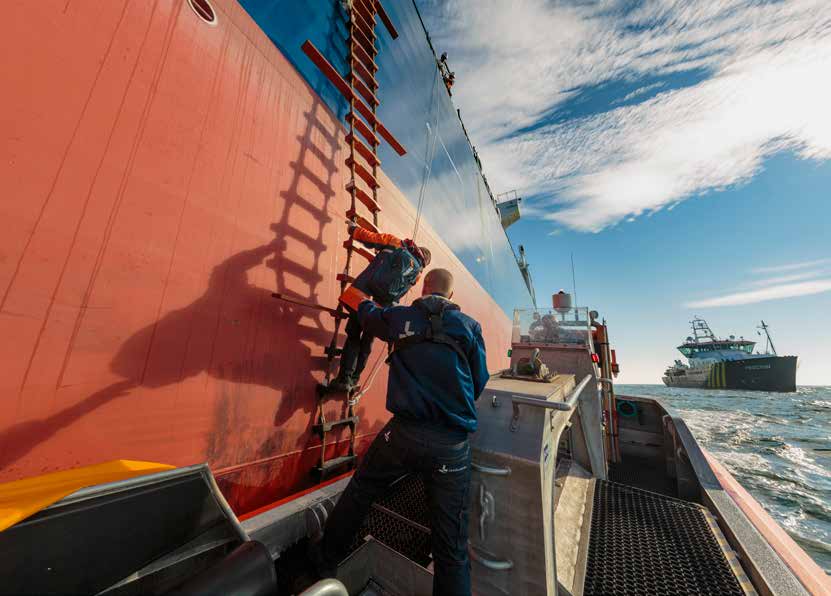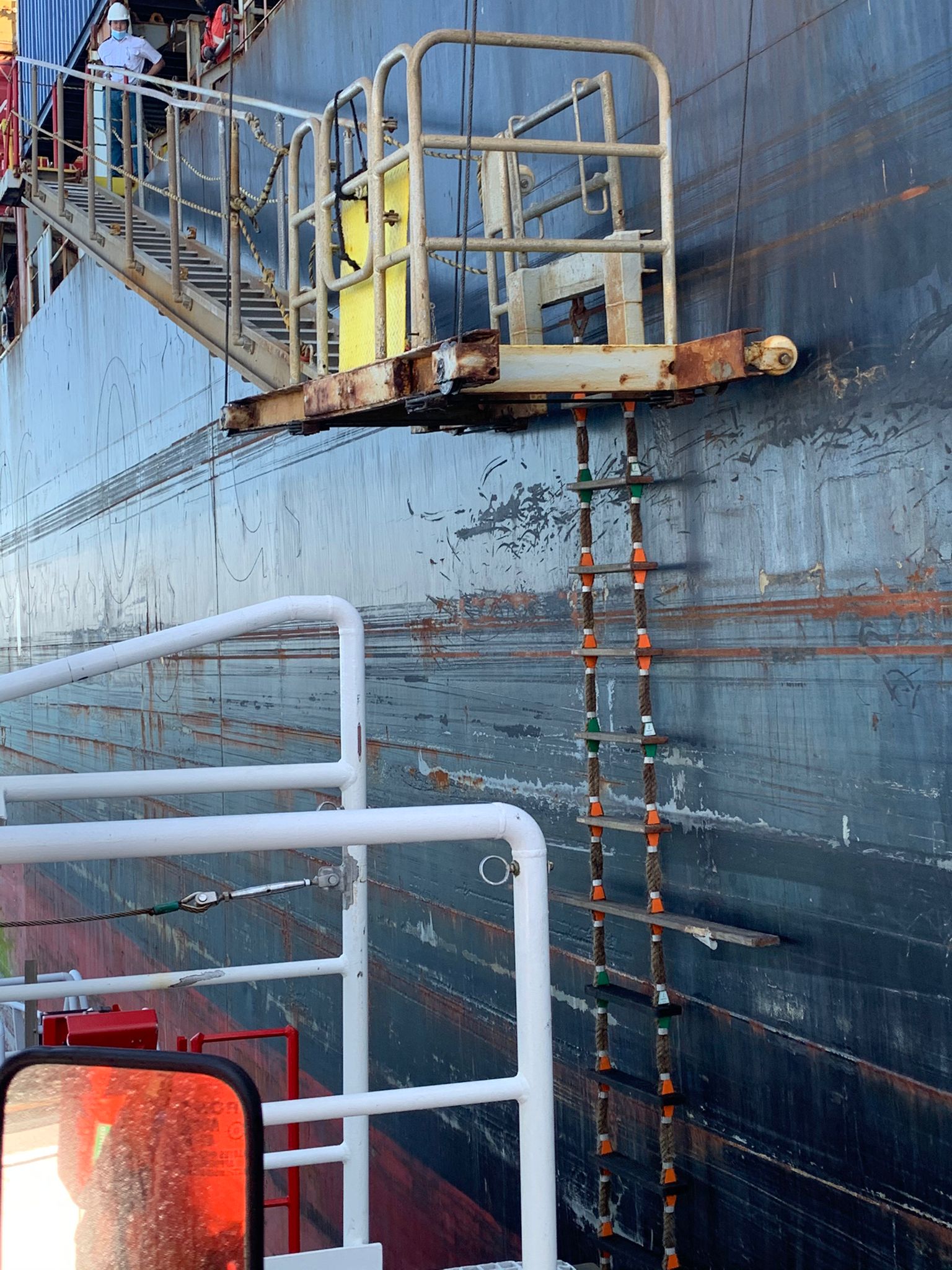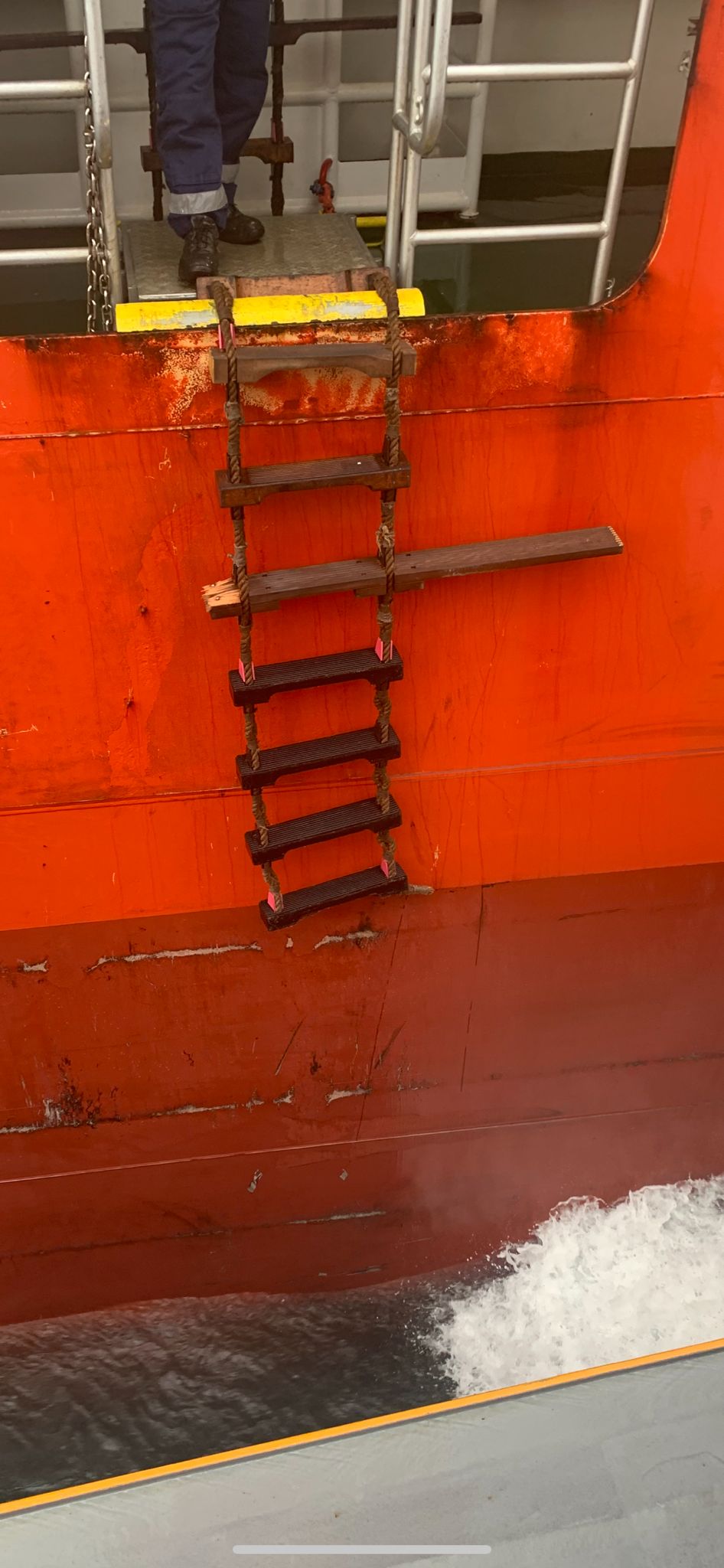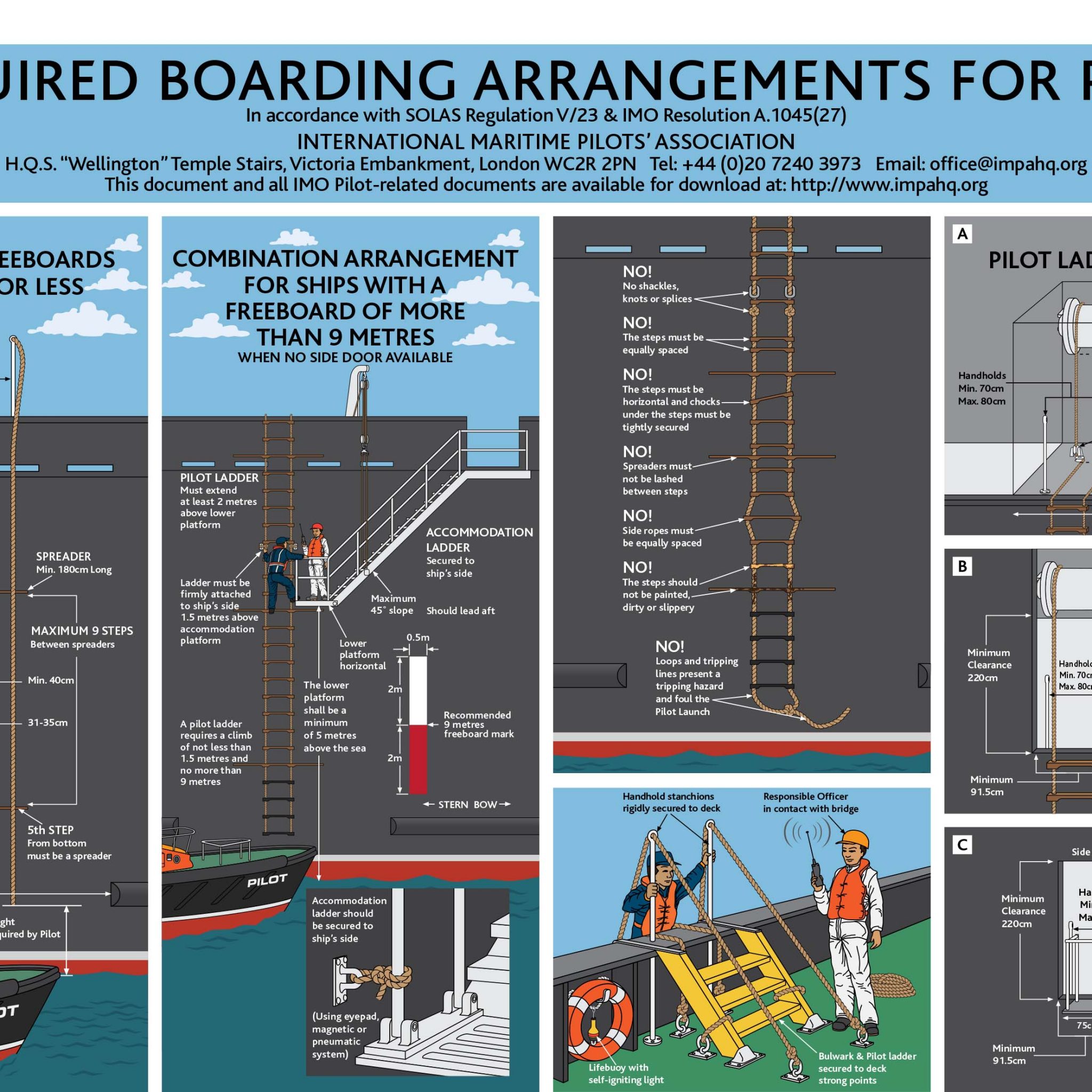Loodsen: “Doden door onveilige loodsladders en onkundige bemanning”
Source: Schuttevaer, 15 december 2021
De internationale loodsenassociatie Impa luidt de noodklok over onveilige loodsladders. Uit een wereldwijde peiling blijkt volgens de loodsen dat de toegang tot het schip via de loodsladder vaak niet voldoet aan de voorschriften. In Europa gaat het zelfs om ruim 17% van de gevallen. De noodzaak tot verandering is groot: jaarlijks vallen er doden.

Ga er maar aanstaan: vanaf een loodsboot die stevig op de golven rijdt overstappen op een huizenhoog schip. In stormweer, bij nacht en ontij. Dagelijks zetten loodsen hun leven op het spel voor een veilige scheepvaart. Dan moet het materiaal wel in topconditie zijn en goed worden gebruikt, zou je zeggen. Maar daar ontbreekt het nog wel eens aan, ondervinden de loodsen. Zij komen defecte loodsladders tegen, met gladde of scheve treden en ladders die verkeerd zijn opgehangen, om maar wat te noemen.
Van de 3322 meldingen die er tijdens de twee weken durende peiling in oktober werden gedaan, kwamen relatief de meeste slechte beoordelingen (‘non compliant’) uit Europa (166) en Azië/Oceanië (122).
Gloednieuw

Arie Palmers is Scheldeloods (Wester- èn Oosterschelde) en moet op de Noordzee vrijwel dagelijks op grote containerschepen, tankers en bulkers overstappen om ze veilig naar de havens aan de Schelde te brengen. Hij zegt dat het niet alleen de schepen onder goedkope vlag zijn, waar de regels niet worden nageleefd. Ook schepen van grote rederijen, of onder een gerespecteerde vlag, hebben hun zaakjes soms niet goed voor elkaar. De sanctie die hij in handen heeft is streng. ‘Als ik een onveilige loodsladder tegenkom, laat ik ze, als het moet, een rondje maken tot de ladder wel veilig is. Soms blijkt dan dat ze ergens een andere, gloednieuwe loodsladder tevoorschijn hebben gehaald. Vaak is de ladder met een kleine aanpassing wel veilig te maken.’
Gangway
Wat gaat er allemaal mis volgens de Impa-loodsen? Veel voorkomende mankementen zijn een ladder die niet tegen de scheepshuid aanhangt, gebroken tredes, tredes die niet gelijkmatig zijn verdeeld, vieze tredes en tredes die niet goed aan het touwwerk zijn vastgemaakt.
Boven de negen meter klimhoogte moet een pilotladder geworden gebruikt in combinatie met een gangway. Anders is klimmen niet meer verantwoord. Het bovenste deel van de ladder moet dan 1,50 meter boven de gangway uitsteken en ook dat is regelmatig niet het geval.
Retrieval line

Het vaakst gaat het mis met de bevestiging van de ‘retrieval line’. Ook Palmers komt dat het vaakst tegen. Die retrieval line zit vast aan het uiteinde van de onderste spreader, die dient om de ladder evenwichtig tegen de scheepshuid te laten hangen. De bemanning kan met de retrieval line de ladder snel optrekken wanneer dat nodig is. ‘Die lijn moet naar de voorkant van het schip wijzen’, zegt Palmers. ‘Anders bestaat het gevaar dat hij bij een onverwachte golfbeweging aan de loodsboot blijft hangen en de hele loodsladder meeneemt. Maar vaak zit hij juist aan de achterkant. Dat laat ik wel veranderen voordat ik op de ladder stap.’
Communicatie
Palmers constateert dat het vaak niet om ondeugdelijk materiaal gaat, maar om ondeskundig handelen van de bemanning. Hij komt ook vaak tegen dat degenen die ladder ophangen geen reddingsvest dragen. Onaanvaardbaar volgens Palmers. ‘Kijk, als iemand overboord valt, en dat is recent nog gebeurd, dan moet de bemanning van de loodsboot het slachtoffer uit het water vissen.’ Wat ook nogal eens gebeurt is, dat er tijdens het aan boord klimmen geen stuurman of andere leidinggevende aan dek is. Dat is wel verplicht, onder meer voor de communicatie met de brug, zegt Palmers. Maar soms kan hij ook wel begrijpen waarom het zo gaat. ‘Dan hebben ze een hele dag in de haven liggen laden of lossen, en zie je een eenzame matroos komen aanlopen. Die heeft ook geen zin meer om zijn collega uit bed te gaan halen.’
Internationale loodsenassociatie Impa

Palmers zet zich al langer in voor veilige werkomstandigheden. Hij vindt dat het schrijven van dikke handleidingen met veel voorschriften weinig zin heeft. ‘Die gaan de matrozen en andere bemanningsleden echt niet lezen. Het gaat om training en explaining. Ik zet bijvoorbeeld veel op social media. Plaatjes werken erg goed.’
Ook heeft hij regelmatig contact met de grote rederijen en voorziet ze van advies.
Solas
De Impa maakt in haar jaarlijkse rapport een vergelijking met de coronamaatregelen. ‘Schepen hebben snel voorzorgsmaatregelen ingevoerd. Het is prijzenswaardig dat afstand houden, mondkapjes en handen wassen inmiddels standaardprocedures zijn geworden aan boord. In contrast daarmee moeten wij helaas constateren dat de handhaving van de al lang geldende Solas-voorschriften (over de loodsladders – red.) nog steeds niet verbetert. Nog steeds raken loodsen gewond of komen om het leven tijdens het overzetten. Net als met veiligheidsmaatregelen rond het virus moet er een omslag komen rond de praktijk van de loodsentransfers.’
English Translation:
Pilots: deaths by unsafe pilot ladders and incompetent crew
The international pilot association IMPA sounds the alarm about unsafe pilot ladders. According to the pilots, a worldwide survey shows that access to the ship via the pilot ladder often does not comply with the regulations. In Europe, it even relates to more than 17% of the cases. The need for change is great: every year there are deaths. It is not easy: from a pilot boat that rides firmly on the waves, change to a house-high ship. In stormy weather, at night and at night. Every day, pilots put their lives on the line for safe shipping. Then the material must be in top condition and used well, one would say. But that is sometimes lacking in the pilot’s experience. They come across defective pilot ladders, with smooth or crooked steps and ladders that are hung incorrectly to name but a few. Of the 3322 reports made during the two-week poll in October, relatively the poorest ratings (‘non-compliant’) came from Europe (166) and Asia/Oceania (122).
Brand new
Arie Palmers is Scheldt pilot and must transfer to large container ships, tankers, and bulkers on the North Sea almost daily to bring them safely to the ports on the Scheldt. He says it’s not just the flags of convenience where the regulations concerning pilot ladders are not being enforced. Even ships of large shipping companies, or under a respected flag, sometimes do not have their act together. The sanction he has in his hands is severe. ‘If I come across an unsafe lead ladder, I let them, if necessary, make a round until the ladder is safe. Sometimes it turns out that they have pulled out another, brand new pilot ladder from somewhere. Often the ladder can be made safe with a small adjustment.’
Gangway
What goes wrong according to theIMPA-pilots? Common defects are a ladder that does not hang against the ship’s hull, broken steps, steps that are not evenly distributed, dirty steps and steps that are not properly attached to the ropes. Above nine meters of climbing height, a pilot ladder must be used in combination with a gangway. Otherwise, climbing is no longer safe. The upper part of the ladder must then protrude 1.50 meters above the gangway and that is also regularly not the case.
Retrieval line
Most often things go wrong with the securing of the ‘retrieval line’. Palmers also encounters this most often. That retrieval line is attached to the end of the lower spreader, which serves to keep the ladder hanging evenly against the ship’s skin. The retrieval line allows the crew to quickly raise the ladder when needed. ‘That line should point to the front of the ship,’ says Palmers. ‘Otherwise, there is a danger that he will get stuck on the pilot boat in the event of an unexpected wave movement and take the entire pilot ladder with him. But often it is right at the aft end of the ladder. I’ll let that change before I step on the ladder.’
Communication
Palmers observes that it is often not about faulty material, but about incompetent actions of the crew. He also often comes across that those who hang up ladder do not wear a life jacket. Unacceptable according to Palmers. ‘Look, if someone falls overboard, and that happened recently, the crew of the pilot boat has to rescue the victim first.’ What also often happens is that there is no responsible officer in charge on deck while climbing on board. This is mandatory, including for communication with the bridge, says Palmers. But sometimes he can also understand why it is so. ‘Then they have a whole day in the port loading or unloading, and you see a lonely sailor coming to the port. He also no longer feels like getting his colleague out of bed.’
International pilotage association IMPA
Palmers has long been committed to safe working conditions. He thinks that writing thick manuals with many prescriptions makes little sense. ‘The sailors and other crew members are really not going to read them. It’s about training and explaining. For example, I put a lot on social media. Pictures work very well.’ He also has regular contact with the major shipping companies and provides them with advice.
Solas
In its annual report, IMPA makes a comparison with the corona measures. ‘Ships quickly introduced precautionary measures. It is commendable that social distancing, masks, and hand washing have now become standard procedures on board. In contrast, we unfortunately must conclude that the enforcement of the long-in-force Solas regulations (on the pilot ladders – ed.) is still not improving. Pilots are still injured or killed during the transfer. As with safety measures around the virus, there must be a change around the practice of pilot transfers.’

